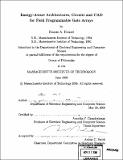Energy-aware architectures, circuits and CAD for field programmable gate arrays
Author(s)
Honoré, Francis
DownloadFull printable version (27.20Mb)
Alternative title
Energy-aware reconfigurable logic array
Other Contributors
Massachusetts Institute of Technology. Dept. of Electrical Engineering and Computer Science.
Advisor
Anantha P. Chandrakasan.
Terms of use
Metadata
Show full item recordAbstract
Field Programmable Gate Arrays (FPGAs) are a class of hardware reconfigurable logic devices based on look-up tables (LUTs) and programmable interconnect that have found broad acceptance for a wide range of applications. However, power consumption is one of the leading obstacles to broader adoption of FPGAs in energy-constrained applications. This thesis addresses active power consumption in FPGAs through the introduction of fine grain configurable power domains. By introducing fine grain power controls, sections of the design that have excess timing margins are able to run at reduced voltage thereby saving power. Delay critical sections can continue to operate at full voltage to maintain the overall performance of the design. A design flow was developed for the analysis and implementation of these configurable power domains. A test chip using dual core voltages fabricated in a 0.18 /m CMOS process features these power reduction techniques. The test chip includes an 8x8 array of logic tiles and a 9x9 switch matrix grid. The chip design flow utilizes a mix of synthesized logic and custom cells. 'The layout required a customized approach to overcome some of the challenges of implementing a fine granularity multiple voltage design. (cont.) A set of benchmark circuits shows a measured average energy-delay improvement of nearly 2X. Additionally, enhancements for the implementation of finite impulse response filters provide a 2.5x improvement in the energy-delay product relative to standard FPGA architectures. This thesis also addresses static: power consumption by reducing sub-threshold leakage through the use of distributed multi-threshold CMOS. A separate test chip using a 0.13 m dual VT process demonstrates the advantages of distributed power gating for sub-threshold leakage reduction by achieving over 10X reduction in static power.
Description
Thesis (Ph. D.)--Massachusetts Institute of Technology, Dept. of Electrical Engineering and Computer Science, 2006. Includes bibliographical references (p. 113-117).
Date issued
2006Department
Massachusetts Institute of Technology. Department of Electrical Engineering and Computer SciencePublisher
Massachusetts Institute of Technology
Keywords
Electrical Engineering and Computer Science.